James Mckay,
Sr. - 6th Mayor Of Tampa
He was the only non-U.S. citizen to serve as Mayor
of Tampa.
He remained a citizen of the United Kingdom
throughout his life.
Born: May
17, 1808
Died: November 11, 1876
Term: February 12, 1859 - February 1, 1860
Captain James McKay was a most unusual man, physically and
mentally. Over six feet tall, he weighed a hundred and
ninety pounds and there was not an ounce of fat on his body.
He was broad-shouldered and had the muscles of a prize
fighter. He was a born leader and for three decades was one
of the most well-known and successful men in south Florida.
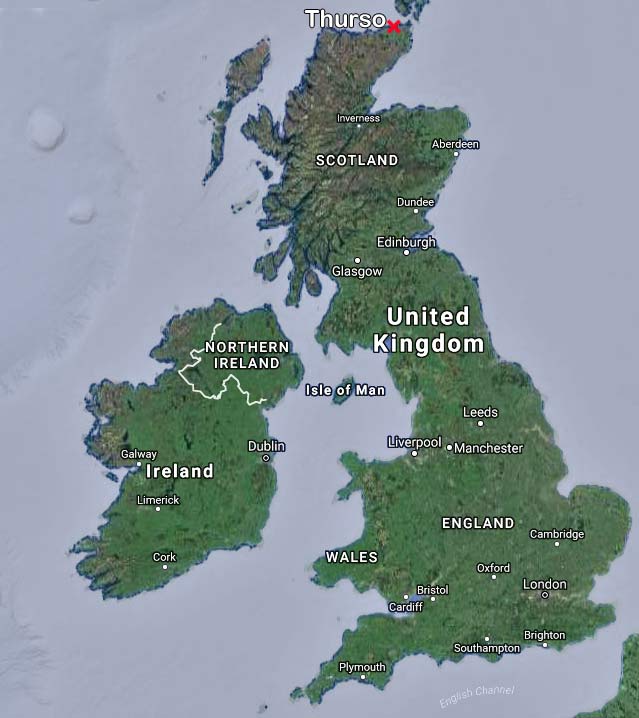
James McKay,
Sr. was born in
Thurso, Scotland, May 18, 1808*,
in the County
of Caithness. For generations, Caithness was the ancestral home
of this sterling Scottish family, whose lineage runs back in
unbroken lines to the time of Robert Bruce and Mary, Queen
of Scots.
*Historian
Karl Grismer
says March 17, 1809
McKay went to sea when a boy and became a master seaman
before he was twenty-five. As a mariner, he spent most
of his time at sea but would return for brief periods to
visit his family.
|
|
Two main sources
below detail the life of James McKay, Sr., but they differ
somewhat on the subject of when he came to America, where he
went first, and when he first met and then married Matilda.
They do agree, however, on their marriage taking place in
the U.S.
Their versions are presented below, in separate columns.
The
City of Tampa Mayors website is
incorrect on the bios of
James McKay Sr. and James McKay Jr. They claim James
Sr. met and married Matilda and had their first four children
in Scotland before coming to the US around 1846, and that
James Jr. was their oldest son, born in Scotland.
This is incorrect, yet it is repeated word for word all over the web,
including Wikipedia. Three consecutive censuses and
numerous historians support the versions that present
their marriage in St. Louis and the birth of all the McKay
children in the United States--the first four in Alabama.
Interspersed among the columns are excerpts from
Charles E. Harrison's
Genealogical records of the pioneers of Tampa and of some
who came after them, published in 1915, and James
McKay, Jr's
"Reminiscences - History of Tampa in the
Olden Days" Dec. 18, 1923, (in brown), and
THE SUNLAND TRIBUNE, Journal of the TAMPA HISTORICAL SOCIETY,
Volume VIII Number 1 November, 1982 - JAMES McKAY, I, THE
SCOTTISH CHIEF OF TAMPA BAY By Tony Pizzo (in pink.) |
|
History of Florida: Past and Present, Historical and
Biographical, Volume 2, pub. 1923 By Harry Gardner
Cutler.
Text version available at USGenWeb Archives. |
Tampa-A history of the city and the Tampa Bay region of
Florida, by Grismer, Karl H, edited by Mckay, D. B, 1950
(Grismer had the advantage of working with Donald B. McKay,
James Sr's. grandson.) |
|
In 1828,
James McKay came to America, locating first in New Orleans,
where for a period of nearly two years he was engaged in
carpentry and building.
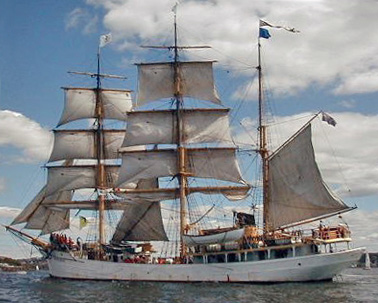
It could
have taken 6 to 12 weeks to cross the Atlantic from Scotland
in a 3-masted barque such as this one. Read more at
the source of this photo: "Crossing
the Atlantic" at Ormiston.com.
He next
located in St. Louis, Mo, where in 1837 he met and married Matilda
Alexander Cail , a native of Scotland, born in Edinburgh, May
19, 1816.
Genealogical records of the pioneers, etc., by
Charles E. Harrison, pub. 1915, states:
"They
never met in the old country, but first became acquainted
with each other in St. Louis, Mo., after both had
immigrated to America. They were married there in
1837. From St. Louis they removed to Mobile, Ala., where
Mr. McKay engaged in mercantile business." |
While in
Edinburgh one day in 1835, James met a bonnie Scotch lass,
Matilda Alexander Cail*, with whom he fell in love. But Matilda was
then only sixteen years old, altogether too young to be
married, in the opinion of her mother, Madame Sarah Cail. To
remove her daughter "from temptation," Madame Cail left
Scotland and went to America, taking Matilda with her. They
settled in St. Louis.
*Matilda and her mother Sarah did not yet have the surname
Cail; their surname was Alexander; her father's surname.
Sarah was widowed.
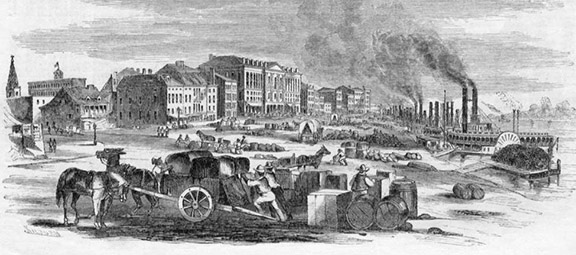
By the
1830s, it was common to see more than 150 steamboats at the
St. Louis levee at one time. Immigrants flooded into St.
Louis after 1840, particularly from Germany.
Wikipedia: 1857 illustration from Ballou's Pictorial
Drawing Room Companion, Boston, Massachusetts. The Levee or
Landing, St. Louis, Missouri, 1857.
Not to be
outwitted so easily, Captain McKay followed, found the Cails
in St. Louis and immediately resumed his courtship. In 1837,
Madame Cail finally relented and gave permission to Matilda
to be married. The captain was then twenty-eight years old
and his bride seventeen.
Soon after the wedding they moved to Mobile, Ala., where the
captain engaged in the mercantile business.
|
The
Alexander and Cail surnames
Noted Tampa
historian Tony Pizzo corroborates the romantic story of
forbidden love in Scotland (although it may be because he
may have used Grismer's work as his source), and details how
the Alexander and Cail surnames came about:
|
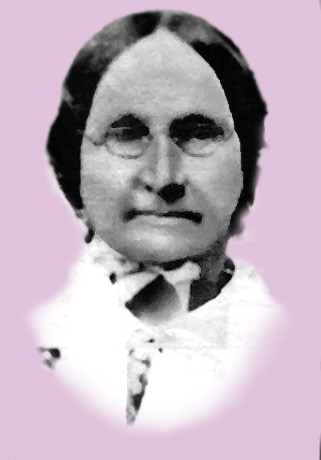 |
|
MADAM
SARAH CAIL 1790-1865
Capt. James McKay’s mother-in-law, Sarah Alexander
Cail. This spirited and strong-willed Scottish lady
earned a niche in Tampa’s pioneer lore for her
independent character, and active part in the social
and religious activities. Her remains rest in the
McKay plot in the historic Oaklawn Cemetery downtown. |
The indomitable
character of the young sea captain was demonstrated early in
life when, in Edinburgh, in 1835, he met and fell in love
with a Scottish lass, Matilda Alexander. Matilda’s mother, a
wealthy widow, disapproved of the match because of McKay’s
hazardous occupation and because Matilda had just turned 15
years of age. To remove her daughter from temptation, Sarah
Alexander and her daughter Matilda Alexander emigrated to
America, settling in St. Louis.
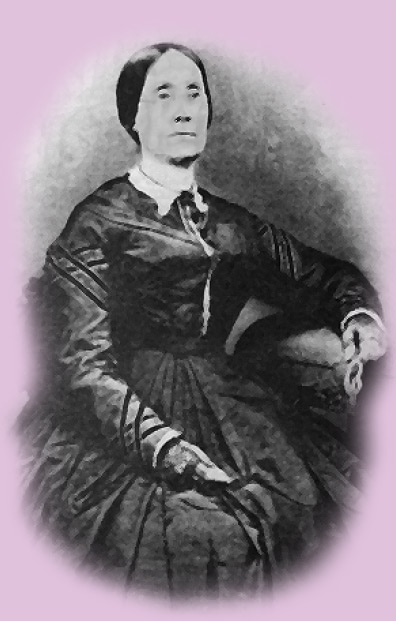 |
|
MATILDA
ALEXANDER CAIL McKAY 1816-1894 Her captivating smiles
attracted James McKay to America, and affected the
course of Tampa history. James and Matilda had five
sons and four daughters. Their uplifting influence did
not cease with their deaths, for they have 1 left a
line of descendants who for four generations have
given priceless service to the Tampa community. |
There Sarah Alexander
married a Mr. Cail, an Englishman who had large investments
in western lands. Mr. Cail disappeared while exploring the
western wilderness, and left Madam Sarah Alexander Cail a widow once again,
but much richer.
In 1837, the persevering
young McKay decided to follow the smiles of his pretty,
blue-eyed sweetheart to America. Having accumulated a
fortune in his own right, he left Thurso on the northern
headland of Scotland, ancestral home of his clan, to visit
his fiancée, and seek his future in America.
In St. Louis, the tall,
broad-shouldered and persuasive young Scot resumed his
courtship of Matilda. This time the mother consented to the
marriage. McKay was 27 years old and the bride 17.
After a few years, the
family moved to Mobile, where Captain McKay engaged in
shipping enterprises. Four of their children were born in
Mobile. In the meantime, Captain McKay had been
investigating the west coast of Florida, and finally decided
to settle in Tampa because "it gave great promise of
developing into an important port city."
Information and images (photos
courtesy of Helen McKay Bardowsky) from:
THE SUNLAND TRIBUNE, Journal of the TAMPA HISTORICAL SOCIETY,
Volume VIII Number 1 November, 1982 - JAMES McKAY, I, THE
SCOTTISH CHIEF OF TAMPA BAY By Tony Pizzo |
|
.
In 1838 James and Matilda moved to Mobile, Ala, where the
couple had their first four children: George, Sarah
I., James Jr. and John Angus.
At Mobile, McKay first worked as a carpenter and builder, but
in 1842 he entered into a partnership with a man named
Brighton, and established a
willow-ware business under the name of McKay and
Brighton. The venture proving unsuccessful, he disposed of
the business in 1846.
Purchasing a small schooner, he brought his family--his
wife, four children, and his mother-in-law to Florida,
locating first at a small place north of Tarpons Springs.
The location was not a favorable one, so he took his family
to Brooksville, where he secured teams and wagons and
continued on to Tampa, arriving at here in September, 1846.
Genealogical records of the pioneers, etc., by
Charles E. Harrison, pub. 1915, states:
They
removed to Florida from Mobile in 1846 and settled first
at Chassewiska, on the coast of Hernando County. They did
not remain long, however, at that place and in the same
year, 1846, removed again, this time to Tampa, which has
been the family home ever since.
|
In
Mobile, Captain McKay met the Rev. Daniel Simmons, the
Baptist minister who had established a mission in
Hillsborough County in 1828 and had lived there until the
Seminole War started, when he went to Alabama. Reverend
Simmons was an ardent Florida booster and never ceased
singing the praises of the Tampa Bay region. Captain McKay
did not need much selling on the future prospects of the bay
section. He knew that because of its geographical location,
Tampa Bay was destined to become one of the leading ports of
the nation. So in the early fall of 1846 he decided to go to
Tampa.
Chartering a schooner, Captain McKay left Mobile with his
family in September, 1846. Reverend and Mrs. Simmons went
with him, and so did Madame Cail and Mitchell McCarty and
his wife, Elizabeth, daughter of the Simmonses.
The
schooner never reached Tampa. It was wrecked during a
hurricane on shoals in Chassahowitzka Bay, in Hernando
County. The cargo was lost but all on board escaped. The
Simmons and McCarty families went on to Brooksville but the
McKays soon afterward made their way to Tampa, arriving in
November. Madame Cail came with them. |
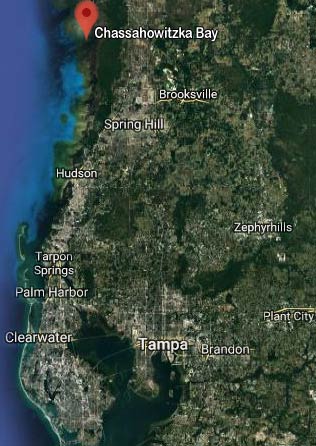 As the McKay schooner
sailed south along the Florida coast, a violent storm drove
the vessel upon a reef near the mouth of the Chassahowitzka
River. Captain McKay, a brawny man, repeatedly swam through
the rough surf to carry his wife, the children, and Madam
Cail ashore. The slaves also survived the shipwreck, but the
entire cargo was lost. They tarried at Chassahowitzka for a
time where Donald B [S, not B], their fourth son, was
born August 8, 1846. [See James McKay, Jr's version of
this below.] As the McKay schooner
sailed south along the Florida coast, a violent storm drove
the vessel upon a reef near the mouth of the Chassahowitzka
River. Captain McKay, a brawny man, repeatedly swam through
the rough surf to carry his wife, the children, and Madam
Cail ashore. The slaves also survived the shipwreck, but the
entire cargo was lost. They tarried at Chassahowitzka for a
time where Donald B [S, not B], their fourth son, was
born August 8, 1846. [See James McKay, Jr's version of
this below.]
The McKay family and Madam
Cail walked from the site of the shipwreck to Brooksville,
where they stayed for several weeks. The trip to Tampa was
trekked in covered ox-wagons through the wilderness. They
trudged through bogs, dense growth of pine and oak, and deep
white sand made the journey quite onerous. They camped at
night close to fresh water and firewood. In the early
morning hours, they wakened to the gobbling of wild turkeys
in concert with the whooping of red-headed cranes and the
hooting of owls. They passed many deer, turkeys, partridges,
and water birds, and repeatedly saw wolf and panther tracks.
The strange, wild scenery and the numerous creatures of the
forest kept the travelers constantly excited and provided
some compensation for the difficulties of their trek through
the wilderness.
On Oct. 13, 1846, the
McKays entered the little village of Tampa which numbered
less than two hundred inhabitants, exclusive of the soldiers
in Fort Brooke. The village consisted of a few crude log
huts thatched with palmetto fronds, with wooden shutters to
keep out the cold and rain. The cottages were scattered over
a sea of white sand. Cattle and pigs roamed at will.
THE SUNLAND TRIBUNE, Journal of the TAMPA HISTORICAL SOCIETY,
Volume VIII Number 1 November, 1982 - JAMES McKAY, I, THE
SCOTTISH CHIEF OF TAMPA BAY By Tony Pizzo |
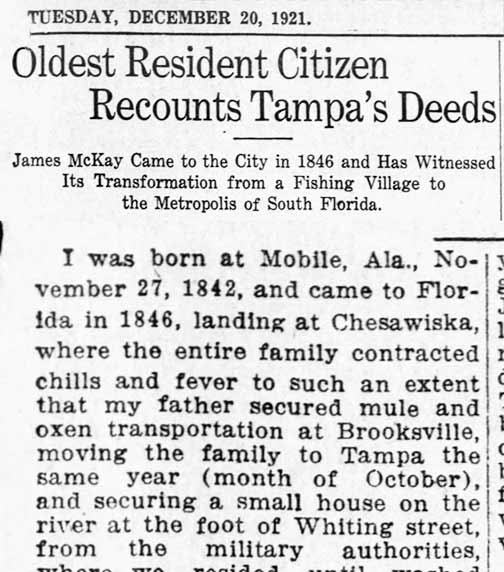
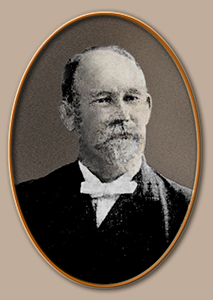
James
McKay, Jr. makes no mention of the storm upon their arrival at
Chassahowitzka from Mobile or any heroic rescue by his father in
the Dec. 20, 1921 article at right, Oldest Resident Citizen
Recounts Tampa's Deeds: |
|

This pencil sketch of the
Captains' Quarters at Fort Brooke was drawn by one of the
officers stationed there in 1845. Beyond the majestic,
moss-laden oak tree at the left is seen the ancient Timuquan
ceremonial mound enclosed by a fence. Leading from the gate
is a path that forks to the left and to the right towards
the top of the mound where a small Chinese summer house was
perched. The ladies of the fort had socials there. Beyond
the small cottage to the right of the mound is a glimpse of
Hooker's Point. The first three large dwellings to the right
of the cottage were the officers' quarters. The fourth
building was occupied by Rev. Henry Axtell, the Army
Champlain, his wife Juliet, and two of their daughters. The
last building to the right was the chapel with its broad
portico and small front yard set out with mulberry trees.
Wide shell and gravel walks criss-crossed the post. The
sketch has been preserved by the family of Chaplain Henry
Axtell for over 150 years. |
|
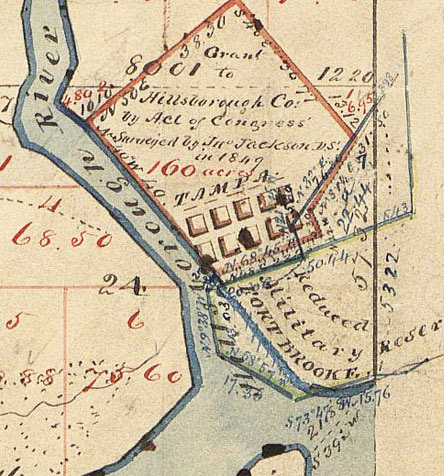 The north side of the government reservation
[Fort Brooke]
ran east and west along Whiting street. The town was
situated north of this line, and was a bed of sand and thick
growth of what was called the scrub. The post office was on
the reservation. At the time our family came to Tampa, the
postmaster was Dr. John M. Palmer. He constructed a small
hotel on the north side of Whiting street near the river and
named it the Palmer hotel. This was a building containing 10
or 11 rooms, with a dining room the entire length of it on
the back, and about 15 feet wide, which was used later on as
a dance hall for the young people. The north side of the government reservation
[Fort Brooke]
ran east and west along Whiting street. The town was
situated north of this line, and was a bed of sand and thick
growth of what was called the scrub. The post office was on
the reservation. At the time our family came to Tampa, the
postmaster was Dr. John M. Palmer. He constructed a small
hotel on the north side of Whiting street near the river and
named it the Palmer hotel. This was a building containing 10
or 11 rooms, with a dining room the entire length of it on
the back, and about 15 feet wide, which was used later on as
a dance hall for the young people.
James
McKay, Jr. in "Reminiscences - History of Tampa in the
Olden Days" Dec. 18, 1923
This
enlargement from an 1852 county land plat shows Ft. Brooke
outlined in green, with the area surveyed by John Jackson in
1849 outlined in brown. The boundary between the fort and
the town was located at today's Whiting St. |
|
The first
home of the McKay family in Tampa was a crude structure at
Fort Brooke, situated on the riverbank at the foot of
Whiting St. This building, which was rented from the
government, was totally destroyed in the disastrous
hurricane which swept over the post in 1848.
Genealogical records of the pioneers, etc., by
Charles E. Harrison, pub. 1915, states:
Some of the older children of this family were born before
their parents' arrival in Tampa, but the majority of
them...were born here. The family was a large one,
consisting of George, James, John Angus, Donald S. and
Charles; sons, and Sarah, Marion, Matilda and Almeria
Belle; daughters.
|
Both
Captain McKay and Madame Cail were well off and soon after
arriving in Tampa they began investing heavily in real
estate, buying some of the best blocks in town as soon as
the property was put on the market. They also purchased many
large tracts throughout the county, becoming two of
Hillsborough's largest land owners. |
|
Plan of the Village of Tampa
Surveyed by John Jackson
Recorded Jan. 9, 1847
It is important to note that the survey recorded on Jan. 9, 1847, wasn't
subdivided as seen below, nor were any properties marked with owners.
It wasn't until April 5, 1847 that lots were sold to the public, so these
details were added later on the 1847 survey. Possibly as each lot
sold, the owner name was added. It is also important to remember
that this was a PLAN and not a map of what the area looked like at the
time. It was up to the city to create these streets according to
this plan. One deviation that can be seen
is that originally, the county courthouse was planned for the block where
you see the Lesley and Givens properties.
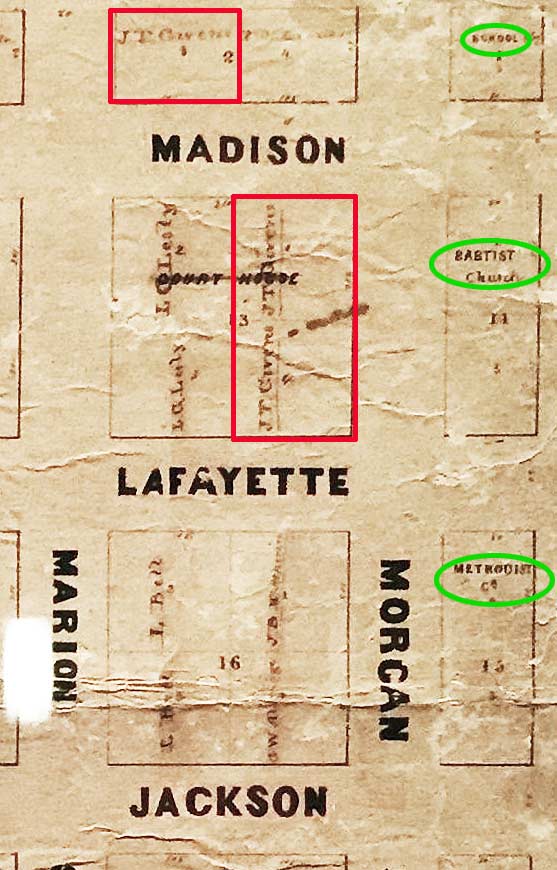
Sarah Cail was one of three land
owners who owned a whole block. Later, her block would be
where the successful hardware business of Knight and Wall would be
built.
The property owners
were added here as best as could be determined according to what was handwritten in the lots. This
was a very low resolution image and extremely difficult to make out the
owner names. It is possible that there is some error here.
Image from
Judge Steele Left His Mark by Rodney Kite-Powell, Jun. 30,
2013, Tampa Bay Times online.
|
1848 HURRICANE
In 1848, the
town was visited by a terrific hurricane causing the tide to
rise above 15 feet above low water mark, washing away the W. G.
Ferris store and the house we were living in; in fact, most of
the houses that were located on the river bank. Our family was
moved to the Palmer hotel, and when driven out of there on
account of the tide, to the Darling and Griffin store, and then
to the military hospital on the reservation.
The Palmer Hotel withstood the hurricane, although the water
rose two feet over the main floor.
As soon as Mr. Ferris could obtain material he erected a small
building on the south side of Whiting street near the
intersection of Franklin, which did not extend farther south, on
account of the reservation.
My father also opened a small store in 1850, at the corner of
Washington and Franklin street, where the Tampa Daily Times is
now published.
1848
Hurricane by James
McKay, Jr. in "Reminiscences
- History of Tampa in the Olden Days" Dec. 18,
1923
|
|
The next location of the McKay home was at the corner of
what became Tampa and Lafayette Street, which was later
occupied by Knight & Wall Co. McKay purchased half the block
for $50 and built his home there. The building was of log
construction, and the lumber used for finishing it was
brought by boat from Mobile, Alabama.
Later, he purchased the block on the northeast corner of
Washington & Franklin St. for $100 and a more commodious and
modern home was built there. On the south side and
opposite corner, was located the building McKay used as a
warehouse and general store, where for many years his
merchandising and other business interests were located.
|
One of the blocks purchased
by Captain McKay was the one bounded by Franklin, Jackson,
Florida and Washington Streets. There he built his home. On
another of his blocks, the one adjoining on the south, he
built a store building and went into business. But he was
not long satisfied with store keeping.
Late in 1848 he purchased a
schooner, naming her
the Sarah Matilda, and started making runs to Mobile
and New Orleans.
Two years later he bought another schooner
Emma, for use between Tampa and Fort Myers.
|
|
After Tampa was platted in
1847, Captain McKay began purchasing land. Old records show
some of his early purchases – two blocks from Jackson to
Whiting Street, between Franklin Street and Florida Avenue,
the Knight and Wall block on Franklin and Kennedy, a large
tract on the river--the site of the Tampa Waterworks, and
police station. On this site, McKay erected a large sawmill
– the first mill in Tampa. The block on which the Masonic
Temple stands on Kennedy and Marion was the site where McKay
erected the Hotel Florida. McKay also owned a large section
of land from Chapin Avenue to Ballast Point, and several
large tracts east of Tampa. He also erected a large building
on the southeast corner of Washington and Franklin in which
he conducted a mercantile store offering “everything from a
knitting needle to a sheet anchor.”
THE SUNLAND TRIBUNE, Journal of the TAMPA HISTORICAL SOCIETY,
Volume VIII Number 1 November, 1982 - JAMES McKAY, I, THE
SCOTTISH CHIEF OF TAMPA BAY By Tony Pizzo |
|
In 1848-49-50 my father owned and operated
the schooner Sarah Matilda (named for my mother) between
Tampa, Mobile and New Orleans. With the exception of the
government vessels, this was the only vessel that was being
used commercially for this port. He also constructed a twin
wharf at the foot of Washington street. Cattle were penned
between the wharves, for shipment to Key West, by schooner.
The Indians having moved to the Everglades
and the country being in a peaceful condition, many settlers
came into the country and some located in Tampa, purchasing
lots and building homes, clearing up the scrub as they would
build, putting down plank sidewalks and in some instances
shell, but the sand remained in the streets making it hard
on teams as well as pedestrians. No lot of 105 feet by 105
feet sold for more than $25 or $140 for the square. That is
what our family paid for the lots where the Olive hotel is,
also The Times lot, and the Almeria hotel square.
by James
McKay, Jr. in "Reminiscences - History of Tampa in the
Olden Days" Dec. 18, 1923
|
|
Capt. McKay became a dominant factor in the up-building of
the community. He established a line of schooners from Tampa
to New Orleans, thus giving to the city business a
connection with the outside world. He built a sawmill on
what was then the outskirts of town, at what would become
the Tampa Heights area on the Hillsborough River, supplying
the town's needs for building purposes.
He accepted contracts to build the first non-log cabin
courthouse for Hillsborough County and carry the mail from
Tampa to Gainesville. He built and owned the only wharf in
the harbor.
|
During the 1850s
he added to his fleet, buying the 125-ton steamer Venice, a
smaller steamer called the Woodduck, and the brigantine
Huntress, purchased at federal auction in Key West after it
had been condemned as a slaver. |
|
In 1850, McKay was
appointed treasurer of Hillsborough County with instructions
to receive “nothing but gold and silver for county
purchases.” For the welfare of his fellow citizens, McKay
established the Loan Money Bank, advancing supplies and
money to the farmers to help them grow their cotton crops
and other staples grown in the county. In 1861, only 153
names appeared on the county tax rolls. Captain McKay
appeared as the principal taxpayer with 404 acres of land
and five slaves valued at $1,000 each.
THE SUNLAND TRIBUNE, Journal of the TAMPA HISTORICAL SOCIETY,
Volume VIII Number 1 November, 1982 - JAMES McKAY, I, THE
SCOTTISH CHIEF OF TAMPA BAY By Tony Pizzo |
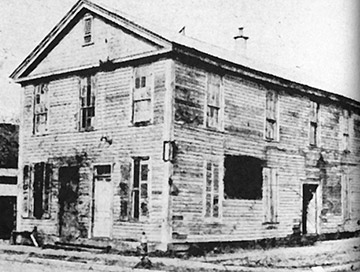 The first Masonic lodge was organized, I think, in 1850 and
the upstairs of my father’s store was fitted up for holding
their meetings, and later on I think in the later part of
1852, the lodge building at the corner of Whiting and
Franklin street was erected, first a two-story building, the
upstairs for a lodge and the lower floor used principally
for school purposes, and later on an addition of a two-story
building at right angle to the first one, was constructed. I
am under the impression that my father was one of the
charter members of this lodge, and had as much if not more
than any other citizen in its organization and construction
but later on had a difficulty with one of the members,
withdrawing from the lodge, saying he would never enter it
again as long as this party was a member, and I do not think
that he ever attended a lodge meeting after that. I am under
the impression that he had several hundred dollars of stock
in this organization which he lost for some reason. If I
have made incorrect statements in reference to this matter
and the lodge has records on file in regard to it, I would
be very glad to be put right in the matter. We children
attended school in this lodge building. Rev. J. K. Glover, a
Methodist minister, was the teacher. The first Masonic lodge was organized, I think, in 1850 and
the upstairs of my father’s store was fitted up for holding
their meetings, and later on I think in the later part of
1852, the lodge building at the corner of Whiting and
Franklin street was erected, first a two-story building, the
upstairs for a lodge and the lower floor used principally
for school purposes, and later on an addition of a two-story
building at right angle to the first one, was constructed. I
am under the impression that my father was one of the
charter members of this lodge, and had as much if not more
than any other citizen in its organization and construction
but later on had a difficulty with one of the members,
withdrawing from the lodge, saying he would never enter it
again as long as this party was a member, and I do not think
that he ever attended a lodge meeting after that. I am under
the impression that he had several hundred dollars of stock
in this organization which he lost for some reason. If I
have made incorrect statements in reference to this matter
and the lodge has records on file in regard to it, I would
be very glad to be put right in the matter. We children
attended school in this lodge building. Rev. J. K. Glover, a
Methodist minister, was the teacher.
by James
McKay, Jr. in "Reminiscences - History of Tampa in the
Olden Days" Dec. 18, 1923
[James McKay, Sr. became a member of Hillsborough Lodge
No. 25, F&A.M. Apr. 10, 1850. He was expelled Dec. 15,
1855 due to a dispute with fellow Mason Madison Post.
McKay was reinstated in the lodge, Sept. 5, 1863.]
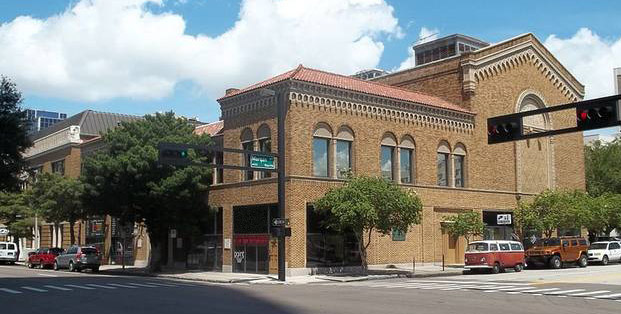
The current home of Hillsborough
Lodge 25
Photo from the Lodge FB page
|
|
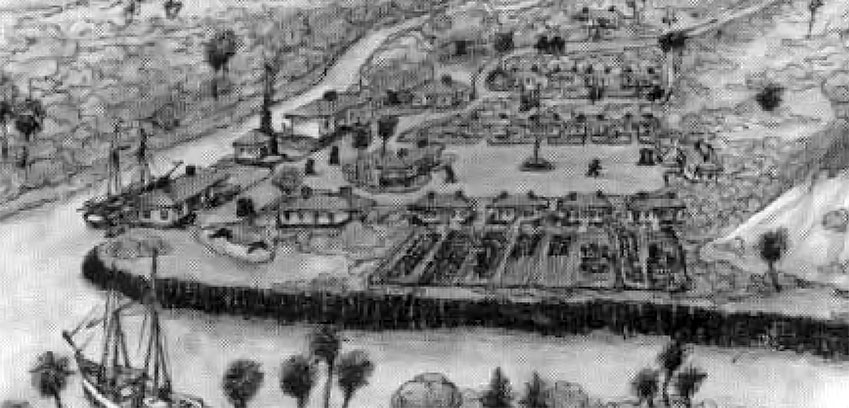
Artist's sketch of
Ft. Brooke as it appeared in 1850
Image from The Mayors of Tampa 1856 - 2015 |
|
In 1851 we shipped cedar logs that were cut from up the
Hillsborough river, to Blanchard and Fitch in New York, for
making pencils. In 1851 my father erected a saw mill at the
place where the Tampa Steam ways is now situated, for the
manufacture of lumber. Previous to this, all lumber was
freighted from Mobile. Sawdust from this mill was placed on
the municipal streets to assist teams in hauling. When the
yellow fever appeared in town many of the citizens claimed
it was from decayed sawdust and the practice was stopped.
Fort Myers was established, I think, in 1850 by the
government. My father was appointed
sutler of this post in 1852 and used a small schooner
named Emma to take his goods from Tampa to Fort Myers. He
also opened a store at Fort Denaud, which was on the
Caloosahatchee river some 20 miles above Fort Myers and
chartered a little steamer he owned, named the Woodduck to
the quartermaster department to carry supplies to the troops
at that place. She was operated between Punta Rassa, Fort
Denaud, and Fort Myers.
The mails were brought to Tampa overland from Gainesville by
stage first weekly, then semiweekly, under contract with my
father in 1852. The first court house was constructed in
[1848] and the second and larger court house was built by
the Rev. John H. Breaker, being a two-story building in
[1854].
by James
McKay, Jr. in "Reminiscences - History of Tampa in the
Olden Days" Dec. 18, 1923
|
|
See details of Tampa's courthouses |
|
In 1852 we opened a ferry at the foot of
Jackson street, so as to cross the stage with the mail. It
was also used by the public. Ponds that were located on the
east end of Jackson street caused the city officials as well
as the people, considerable annoyance, especially during the
rainy season. One of these ponds at the corner of Jackson
and Marion street would take in all four corners and prevent
pedestrians from passing in that direction. I have skated
rocks over ice on this pond when it was frozen over during
the winter.
The authorities dug a ditch in the center of
Jackson street to drain these ponds, and in some places it
was 12 feet deep. Across Franklin and Tampa streets small
bridges were placed so as to permit passage of teams and the
public. This did not accomplish what was desired so the
ponds were filled in later on.
by James
McKay, Jr. in "Reminiscences - History of Tampa in the
Olden Days" Dec. 18, 1923 |
|
It
has been remarked that Tampa had not been visited with a
hurricane since 1848 until the one of 1921, which is an
error, Tampa was visited with a pretty stiff hurricane in
1853, that I recollect very well. The schooner John Roalef
owned by W G. Ferris and sons arrived from New Orleans with
a cargo of general merchandise and just as she had finished
discharging this cargo, this hurricane came along, bringing
in a tidal wave with it that landed this vessel about 100
yards north of the A. C. L. railroad warehouse where it
stands now and about 100 yards from the river bank. My
father bought this vessel, had her jacked up and repaired,
dug a canal to the river and launched her into this canal,
floating her. The tide must have risen some 10 feet above
low water mark as this vessel was drawing some five feet or
more of water, at the time she went ashore.
by James
McKay, Jr. in "Reminiscences - History of Tampa in the
Olden Days" Dec. 18, 1923 |
|
By personally guaranteeing the company against financial
loss, he induced the Morgan Steamship Company to have two of
their vessels, on the route from New Orleans to Havana, make
semi-monthly calls at Tampa and other points in Florida.
This was in 1856 and the same year he established a
merchandising and trading business in Fort Myers, another
post garrisoned by US troops. |
|
|
In 1857 during the
summer, Tampa was visited by an epidemic of yellow fever, but it being very late
in the summer and cold weather coming on, there were not many cases and but few
deaths, but in 1858 it started early in the season and spread rapidly over the
town. All that could move to the country did so but there were many deaths, some
of our best citizens passing away. I was stricken with the disease and only for
my mother and grandmother, being most excellent nurses, they having passed
through an epidemic in Mobile sometime previous, I would not be here today
writing this article.
There were many theories advanced from what source came
the disease. Some stated that it was introduced from New Orleans by schooner.
Others claimed it originated from filth in the town. Any way there was a
campaign of cleanliness and sanitary measures were adopted in the winter of ’58
and early ’59. These measures were rigidly enforced and before the summer of ’59
came in, the town, was placed in fine shape. But it gave the town a setback from
which it did not recover for two years.
by James
McKay, Jr. in "Reminiscences - History of Tampa in the
Olden Days" Dec. 18, 1923
|
|
In 1858 my father came
to the conclusion the country would be benefited from the exportation of cattle
to Havana, Cuba, so he purchased the brig Huntress, fitted her up with cattle
pens and contracted with the Morgan Steamship Line to load their decks twice
each month, paying $1,500 per trip, whether he loaded the decks or not. He
constructed a small dock at Ballast Point and lightered the cattle out of these
vessels. Through this source quite a sum of money was placed
in circulation in south Florida. In fact after the military left this part of
the country the shipment of cattle was the only source of obtaining money. There
was only a small amount of sea island cotton made in this section and some
potatoes, sugar and hides. These were brought to town and sold in trade, for
other goods.
by James
McKay, Jr. in "Reminiscences - History of Tampa in the
Olden Days" Dec. 18, 1923
|
|
He expanded his cattle business until it attained such
proportions that in 1859 he fenced off the Gadsden Point
peninsula, the fence extending from where the Spanish
sanitarium stood to a point on Old Tampa Bay, about a mile
north of today's Port Tampa, and in this pasture grazed
thousands of head of cattle in preparation for their
shipment to Cuba.
McKay was
joined in this endeavor by other Hillsborough County
residents, notably the Lesleys, Lykes and Hookers. [Tampa
Bay History Center Blog] |
In 1859 he chartered the
steamer
Magnolia from the Morgan Line and entered the cattle
business, buying herds and selling the them in Cuba. He
is credited with being the first shipper of cattle from
Florida to the Cuba market.
|
Magnolia, a wooden, seagoing, sidewheel steamer built
by J. Simonson of Greenpoint, New York for Charles
Morgan's Southern Steamship Company. Launched in 1854,
the ship was impressed as a public vessel in New
Orleans, Louisiana, 15 January 1862, by Maj. Gen.
Mansfield Lovell, CSA, acting for the Confederacy's
Secretary of War Judah P. Benjamin. The South’s
original plan to arm her as a ram was dropped in favor
of turning her into a blockade runner. In 1858
Floridian cattle man Captain James McKay Sr. of Tampa
made a contract with the Morgan Line. This contract
allowed McKay to use Magnolia twice a month at a price
of $1,500 each run in order to ship cattle to Cuba,
making Magnolia the first of many ships to be used in
the same way. For this reason, the introduction of
Spanish doubloons to Florida can be traced back to the
trading trips made by Magnolia. |
|
|
In January,
1860, there was constructed a pasture fence, beginning on Hillsborough Bay just
near the present site of the Spanish sanitarium, extending across the peninsula
about two miles north of Port Tampa, to old Tampa bay, for the purpose of
concentrating cattle.
The demand for cattle had increased to such an extent that
my father in the spring of this year went north to purchase a steamer suitable
for the trade and after searching the eastern ports, not finding a suitable
vessel, went to Chicago and there purchased the steamer Salvor. She was not of
sufficient size for the trade, so he took her to New York, cut her in two,
putting 70 feet in the middle of her.
Before leaving Tampa he purchased from
Captain L. G. Lesley, his entire stock of the S. V. brand of cattle, as well as
2,000 head of beef cattle from other parties. These cattle were all delivered to
this pasture by June 5. The steamer should have arrived here by June 1, but
owing to the slow manner of completing the work on her, she did not reach Tampa
until the middle of July. In the meantime the pasture went dry, not a drop
of water for cattle and many died before the rains began. There were only about
some 3,500 head that were in a condition to stand shipping, and those that were
left alive, we altered the marks and brands and drove to Manatee county. The pen
where I received all this number of cattle, some 8,000 head, was situated some
200 yards from where I am now living. At that time there was but one house
within one mile of the pens. What wonderful improvements have I witnessed since
that time.
by James
McKay, Jr. in "Reminiscences - History of Tampa in the
Olden Days" Dec. 18, 1923
|
|
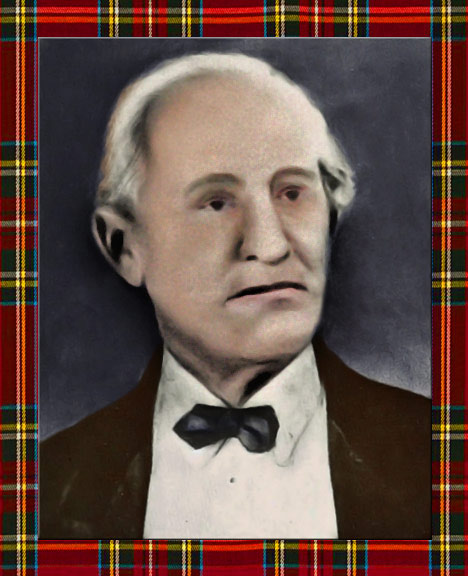 McKay served
as Tampa's 6th mayor, from February 12, 1859 to Feb.
1, 1860, and established the use of standard procedures and
forms for licenses, ordinances and legal notices. He also
regulated the Jackson Street ferry service in town to ensure
the safety of passengers and cargo. McKay also attempted to
purchase the Fort Brooke military reservation for Tampa but
was only able to negotiate a rental agreement. For eighteen
months, the City rented Fort Brooke from the U.S. government
until April 1861 when Confederate troops occupied the fort
and declared marshal law in Tampa. McKay served
as Tampa's 6th mayor, from February 12, 1859 to Feb.
1, 1860, and established the use of standard procedures and
forms for licenses, ordinances and legal notices. He also
regulated the Jackson Street ferry service in town to ensure
the safety of passengers and cargo. McKay also attempted to
purchase the Fort Brooke military reservation for Tampa but
was only able to negotiate a rental agreement. For eighteen
months, the City rented Fort Brooke from the U.S. government
until April 1861 when Confederate troops occupied the fort
and declared marshal law in Tampa.
With the outbreak of the
Civil War, McKay and a handful of other local men used their
vessels to run the Union Naval Blockade
to bring guns, ammunition, foodstuffs and other merchandise
for the Confederate army and civilian population in Tampa
and the surrounding area.
From
City of Tampa Mayors:
James McKay, I,
Master mariner.
Photo
colorized from Tampa Bay History Center Blog
|
|
|
|
In the summer of 1860, McKay
experienced a disaster due to the late arrival of his new
ship, the Salvor. Having just purchased it in Chicago, the
ship was being lengthened in New York. The
modifications to the Salvor in New York took longer than
expected so thousands of his cattle died of thirst while
waiting to be shipped south from Tampa. This resulted in
McKay and other cattlemen to shift their operations from
Tampa to the Peace River at Charlotte Harbor in order to
take advantage of the better opportunities for selling
cattle from there.
The Republican presidential
victory and the ensuing clamor for secession prompted McKay
and other cattlemen to step up their operations. Business
was booming for McKay as he made numerous runs to Key West,
Cuba and the Tortugas, but this was to soon open a
"Pandora's box" for McKay.
On June 6, 1861, McKay's
cattle boat Salvor was detained by the U.S. Navy at Key
West. The Navy then leased the ship from McKay for their own
use and allowed him to return to Tampa in a fishing smack.
Soon after his arrival in Tampa, McKay was arrested for
treason and charged with supplying beef to the Union enemy.
Florida's Peace River Frontier, by Canter Brown, Jr.
On August 10, 1861, McKay was
brought to trial in Tampa on treason charges. The
trial was held before two justices of the peace at the
Hillsborough County courthouse and the volunteer prosecutor
was Senator James T. Magbee. Magbee called for the
death penalty, demanding that McKay be hanged. However, the
Justices of the Peace avoided judgment by binding the
captain over for a new trial at the October term of the
circuit court. Arrangements were made for McKay to
pass the new Union blockade and head for Key West; he was
required to post a bond of $10,000. Soon after, McKay was
allowed to leave Tampa and resume his business activities.
He fled to Key West.
|
|
On October
13, 1861, McKay, who had gone to Key West after his trial
in Tampa, was traveling with his son and crew from
Havana aboard his steamer Salvor when he was captured by the USS Keystone State. A
search of the Salvor reportedly found 600 pistols and rifles, 500,000
percussion caps, coffee, cigars and clothing.
They were brought into Key West where McKay, his son
Donald,
and his crew became prisoners of war and his steamer with
its cargo
was confiscated.
More on
this topic is presented on this separate TampaPix page:
"The Capture of the S.S. Salvor and
Imprisonment of James McKay, Sr." |
|
From the summer of 1862
through October, 1863, McKay made six runs in the Scottish
Chief through the Union naval blockade to Havana. At
first he carried cattle, but as time went on he shifted to
cotton, a commodity at once more profitable than cattle and
more easily handled. On return trips McKay brought
back commodities and supplies needed by local civilians,
McKay's blockade running career ended on the morning of Oct.
17, 1863, when a Union raiding party, guided by Tampan Henry
A. Crane, discovered and burned the Scottish Chief while it
was moored in the Hillsborough River.
Florida's Peace River Frontier, by Canter Brown, Jr.
Continue with the Hillsborough River Raid on Magbee & the
Civil War in Tampa, page 2 |
|
After the Hillsborough River
raid, Confederate Major
Pleasant W. White appointed McKay Commissary Agent for the
5th District of Florida.
True to his promise made to the
Union, McKay seems to have frustrated attempts to supply the
Confederate army with beef using a series of excuses ranging
from "bad weather, lack of funds, a scarcity of cow hunters
and drivers and poor health." As a result, the cattle
shipments that did arrive from Florida were far below the
needs of the Confederate Army. Extremely displeased with the
number of cattle being transported to the army, the
Confederate government conducted inspections of the cattle
and methods of supply but could not determine if there were
intentional delays.
See McKay excuses
After the
war, McKay resumed his cattle and shipping business until
1876 when he had an accident from which he never fully
recovered. He died in Tampa on Nov. 11, 1876. |
|
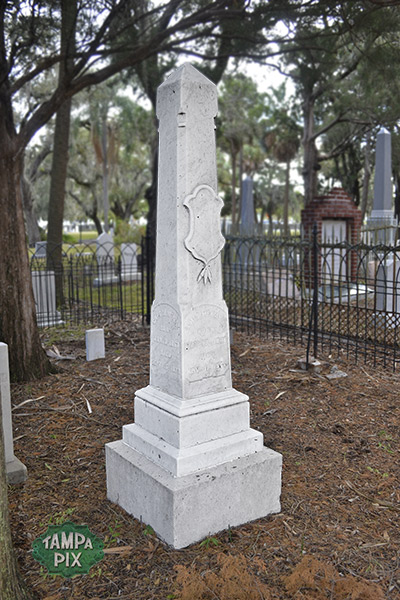
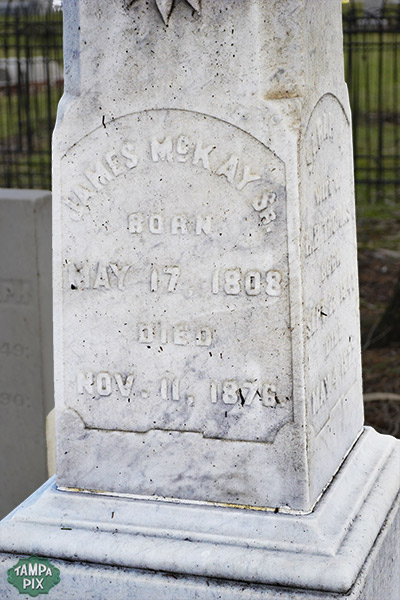
If Captain
McKay were living today, he would be classified as an
entrepreneur. He was an amazing man – a natural leader
with great ability and an uncanny flair for business. Fate
dealt him many reverses throughout his lifetime, but he
never wavered; he forged ahead despite the setbacks.
--Tampa historian, Tony Pizzo
|
|
McKay Family Censuses in Tampa
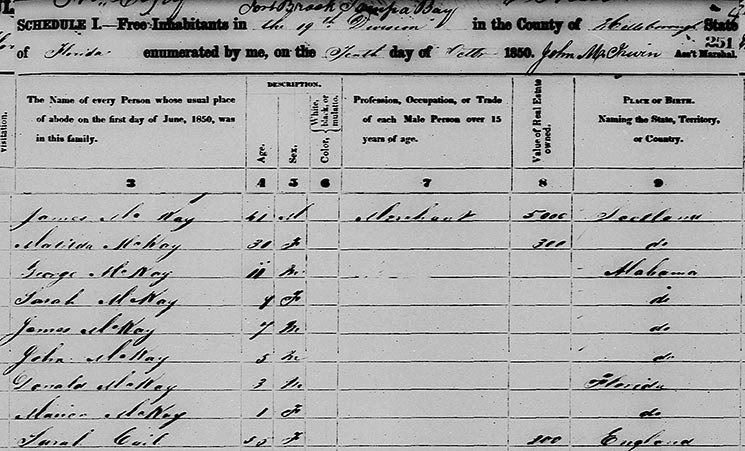 |
|
Their 1850
Census shows James & Matilda's first four children, George,
Sarah, James & John, all born in Alabama.
Donald and Marian born in Florida, and Sarah Cail, Matilda's
mother, born in England.
|
|
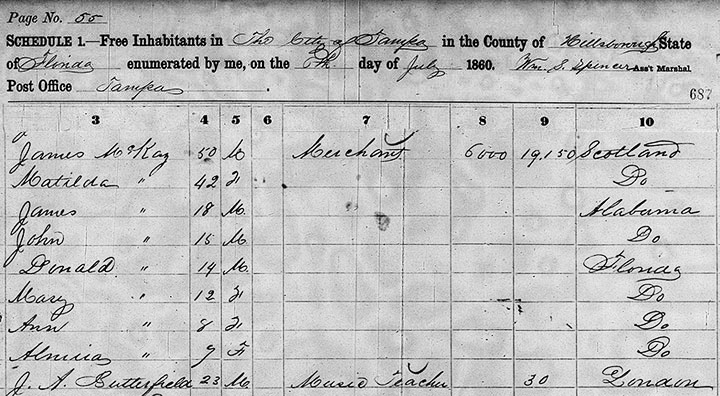 |
|
1860 Census of the McKay Family in Tampa
The McKay's had a music teacher from London in their
household--J.A. Butterfield.
See the table of combined census info below for explanation
of names.
|
|
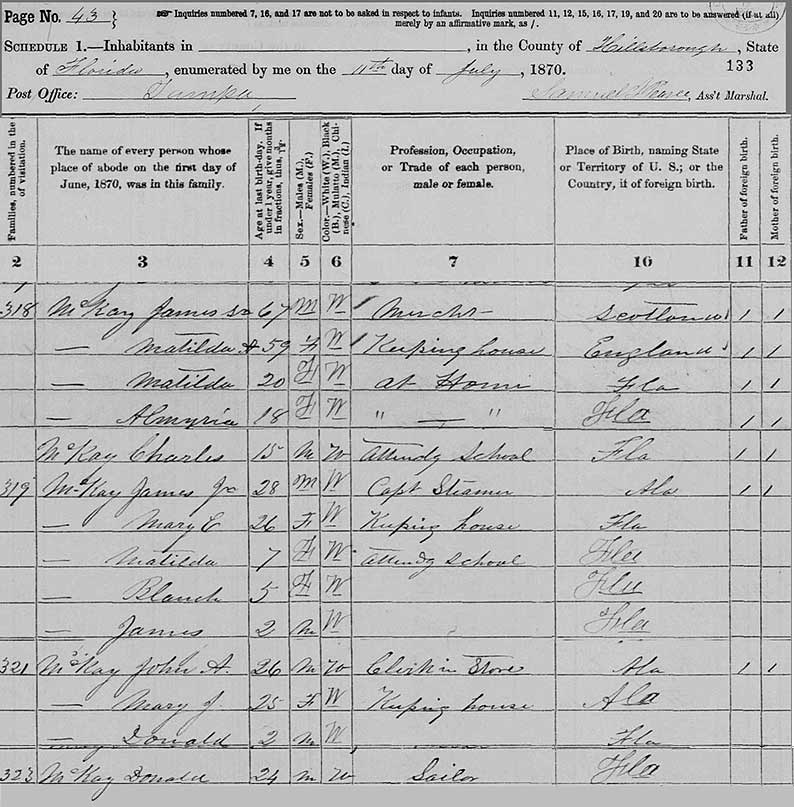
1870 Census of
McKay family members
It wasn't until the
1880 census that the relationship to head of house for each
person was recorded.
Res. 319 James Jr. now married to Mary E. (Crichton) with 3 children,
Res. 321 John A. married to Mary J. (McCarty) with son Donald.
(This is Donald Brenham McKay.)
Res. 323 Donald (S.) now living in his own residence.
Enumerator failed to record a "1" for
"Parents of foreign birth" in Col. 11 & 12 for Donald.
This census has been pieced together from 2 successive
pages; the 2nd page starting with 15-year old Charles McKay.
(See table below for notes concerning Charles.) |
|
McKay Family Census Comparisons
|
Name |
|
Census Names |
|
Age |
Calculated Birth Year |
Birth Place |
|
1850 |
1860 |
1870 |
1850 |
1860 |
1870 |
1850 |
1860 |
1870 |
1850 |
1860 |
1870 |
|
James Sr |
James |
James |
James Sr. |
41 |
50 |
67 |
1809 |
1810 |
1803 |
Scotland |
Scotland |
Scotland |
|
Matilda |
Matilda |
Matilda |
Matilda A. |
30 |
42 |
59 |
1820 |
1818 |
1811 |
Scotland |
Scotland |
England |
|
George |
George |
D |
D |
11 |
D |
D |
1839 |
D |
D |
Alabama |
D |
D |
|
Sarah I. (Thomas) |
Sarah |
Sarah |
NF |
9 |
20 |
NF |
1841 |
1840 |
NF |
Alabama |
Mobile, Ala |
NF |
|
James Jr |
James |
James |
James Jr. |
7 |
18 |
28 |
1843 |
1842 |
1842 |
Alabama |
Alabama |
Alabama |
|
John Angus |
John |
John |
John A. |
5 |
15 |
26 |
1845 |
1845 |
1844 |
Alabama |
Alabama |
Alabama |
|
Donald S |
Donald |
Donald |
Donald |
3 |
14 |
24 |
1847 |
1846 |
1846 |
Florida |
Florida |
Florida |
|
Marion E. (Randolph) |
Marion |
Mary |
Marion |
1 |
12 |
21 |
1849 |
1848 |
1849 |
Florida |
Florida |
Florida |
|
Matilda Ann (Wall) |
NA |
Ann |
Matilda |
NA |
8 |
20 |
NA |
1852 |
1850 |
NA |
Florida |
Florida |
|
Almeria Bell (Lykes) |
NA |
Almeria |
Almyria |
NA |
7 |
18 |
NA |
1853 |
1852 |
NA |
Florida |
Florida |
|
Charles M. |
NA |
NL |
Charles |
NA |
NL |
15 |
NA |
N.L. |
1855 |
NA |
NL |
Florida |
|
NA=Not Applicable |
NL=Not Listed |
NF=Not Found |
D=Deceased |
|
|
|
|
|
|
George died 1859, buried in Oaklawn
Cem. |
|
|
|
|
|
|
|
|
|
|
|
Charles first appears on the 1870 census with parents showing foreign
birth; he was omitted on the previous census, 1860.
In 1874 his brother John A. McKay had a son
named Charles.
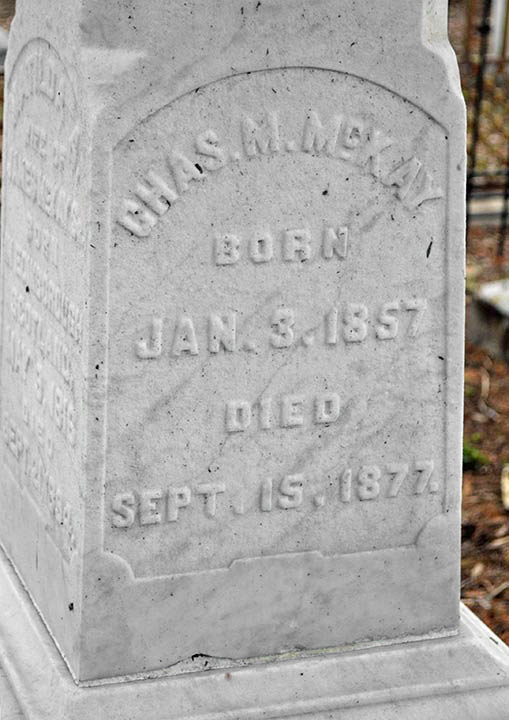 |
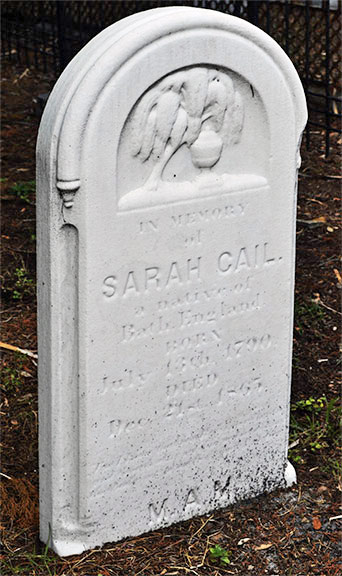 |
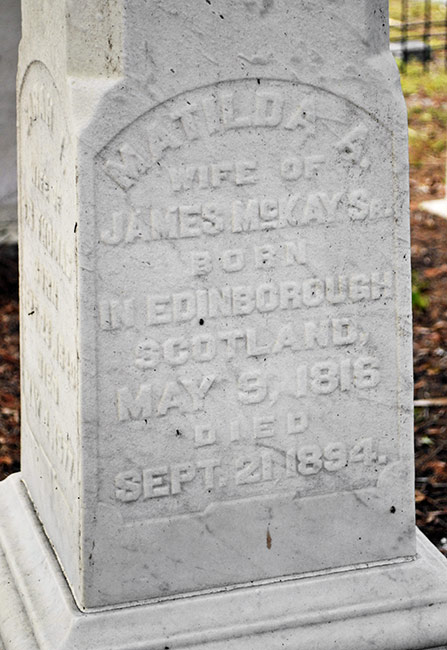 |
|
Charles M. McKay, son of James Sr.
and Matilda McKay. B. Jan 3, 1857, D. Sept. 15,
1877. |
Sarah Cail, mother-in-law of James
McKay, Sr. Native of Bath, England, born July
13th, 1790, died Dec. 21st, 1865. |
Matilda A.
McKay, wife of James Sr. Born Edinborough,
Scotland May 9, 1816 D. Sept. 21, 1894. |
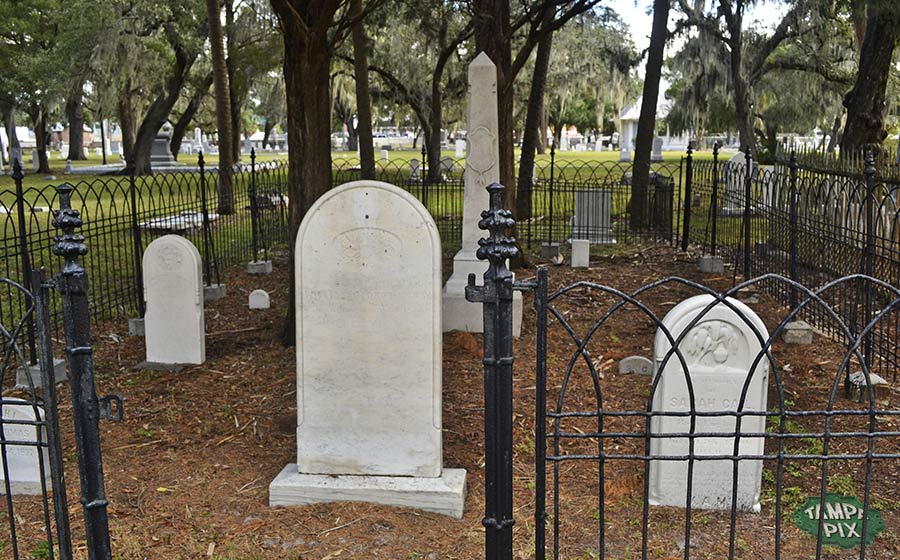
Left: Matilda McKay (Wall), wife of Dr.
John P. Wall, center: William George McKay, right: Sarah
Cail, mother-in-law of James Sr.
Genealogical records of the pioneers, etc.,
by
Charles E. Harrison, pub. 1915, states:
-
George, the first
son, died in early manhood, unmarried.
-
Sarah, married
Robert B. Thomas of Kentucky.
-
James Jr. married
Mary E. Crichton, the mother of all his children,
2nd marr. to Helene Turton, of Mass., and 3rd time to
Lillian Nimms Warren, of NJ.
-
John Angus married
Mary Jane McCarty.
-
Donald S. was
born at Chassewiska, Aug 8, 1846, and came to Tampa
with his parents in the same year. He married Mary
M. Collier, then 2nd to Martha A. Hayden.
-
Marion
E. married
William Randolph of Tallahassee.
-
Matilda
Ann married Dr.
John P. Wall.
-
Almeria Belle
married Howell T. Lykes, of Brooksville.
-
Charles McKay
was not
mentioned by Harrison. Charles died at
age 20 in 1877.
|
|
THE JAMES MCKAY,
SR.
HOMESTEAD |
|
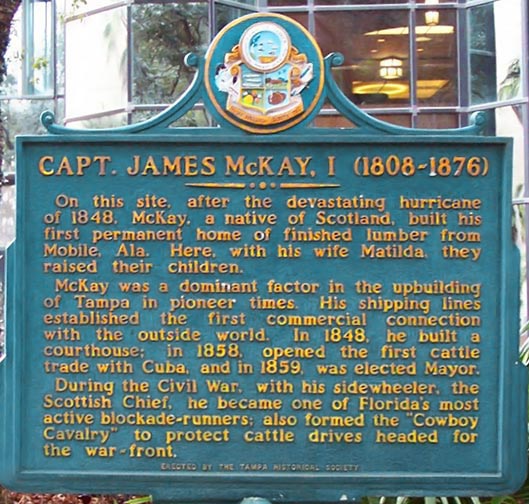 |
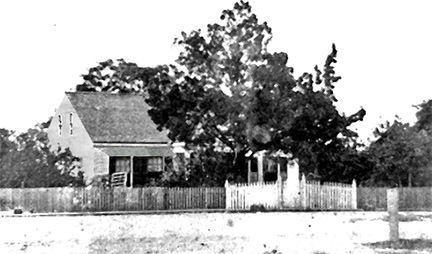
THE OLD McKAY
HOMESTEAD
This was the homestead of Capt. James McKay. This view shows
the home in the 1870s, and was located on the southeast
square of Franklin and Jackson Streets, the present-day site
of the Tampa City Center skyscraper. The McKay children were
reared in this house.
Photo courtesy of Helen McKay Bardowsky
Historic marker from Exploring Florida
McKay homestead from
THE SUNLAND TRIBUNE Volume VIII Number 1 November, 1982 |
|
Capt. James
McKay, I (1808-1876). On this site, after the devastating
hurricane of 1848, McKay, a native of Scotland, built his
first permanent home of finished lumber from Mobile, Ala.
Here, with his wife Matilda, they raised their children.
McKay was a dominant factor in the upbuilding of Tampa in
pioneer times. His shipping lines established the first
commercial connection with the outside world. In 1848, he
built a courthouse; in 1858, opened the first cattle trade
with Cuba, and in 1859, was elected mayor. During the Civil
War, with his side wheeler, the Scottish Chief, he became
one of Florida's most active blockade-runners; also formed
the "Cowboy Calvary" to protect cattle drivers headed for
the war-front." (Tampa Historical Society)
|
|
|
TRIBUTE TO JAMES MCKAY, SR. AT TAMPA'S RIVERWALK

Photos and info below are from the Historical Monument Trail
website, Friends of the Riverwalk.
|
|
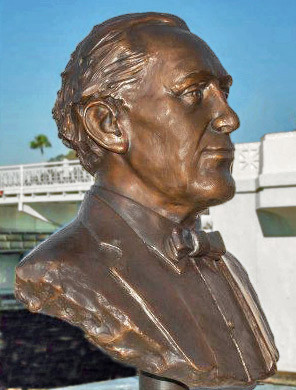
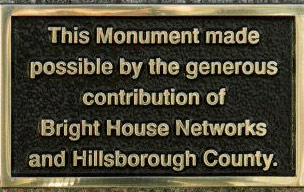 |
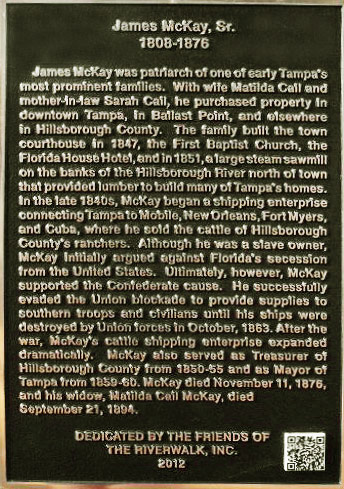 |
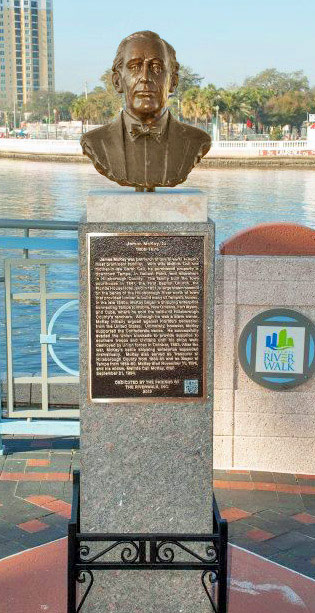 |
|
James McKay was born in northern Scotland 1808. As a
young man, he took a liking to the sea and became a master mariner. McKay
moved to the United States where he married Matilda Cail, who was born in
Edinburgh, Scotland. In 1846, James and Matilda, along with her mother,
Sarah, moved to Tampa. McKay purchased property downtown as well as in the
Ballast Point vicinity and elsewhere in Hillsborough County. |
|
He built a downtown courthouse in
1847, the First Baptist Church, the Florida House Hotel, and in 1851, a
large steam sawmill on the banks of the Hillsborough River north of town
that provided lumber to build many of Tampa’s homes. Shortly after
the severe 1848 hurricane, McKay began a shipping enterprise connecting
Tampa to Mobile, New Orleans, Fort Myers and ultimately Cuba, where he
sold the cattle of Hillsborough County’s ranchers.
Although he was a slave owner, McKay
initially argued against those who called for Florida to join the
Confederate secession from the United States. Ultimately, however, McKay
supported the Confederate cause. He successfully evaded the Union blockade
to provide supplies to southern troops and civilians, until his ship was
destroyed by Union forces in October 1863. After the war, McKay’s cattle
shipping enterprise expanded dramatically. He also briefly served on the
county commission in 1870, adding to his earlier periods in public office
as mayor of Tampa in 1859-60, and as the treasurer of Hillsborough County
in 1850. McKay died November 11, 1876, and his widow, Matilda Cail McKay,
died September 21, 1894. |
|
SOURCES
(For this feature and the Ulele Springs history feature)
-
Beck Group, Architects, Constructors, website
-
Bureau of
Land Management, Government Land Office records
-
Biographical Directory of the United States Congress, 1774 -
Present
-
Biographical Sketches of Circuit Judges, Florida's 10th Judicial
Circuit - James T. Magbee
-
Blockaders, Refugees, & Contrabands - Civil War on Florida's
Gulf Coast, 1861-1865 by George E. Buker, "Henry Crane -
Unionist"
-
City of Tampa Local Historic Landmarks
-
City of Tampa Parks & Recreation Dept., Oaklawn Cemetery
-
City of Tampa website, Previous Tampa Mayors
-
Civilwaralbum.com, Courthouse Civil War Monument
-
Ecosphere Restoration Institute
-
Exploring Florida, Maps ETC.
-
Exploring Florida, Capt. James McKay, I, historic marker
-
Familysearch.org, census records, marriage records
-
Florida Civil War Blockades: Battling for the Coast By Nick Wynne,
Joe Crankshaw
-
FLORIDA HISTORICAL QUARTERLY, Vol. 70, No. 4, April 1992 -
TAMPA’S JAMES MCKAY AND THE FRUSTRATION OF CONFEDERATE
CATTLE-SUPPLY OPERATIONS IN SOUTH FLORIDA by CANTER BROWN, JR.
-
Florida Memory, State Library & Archives of Florida, Photographs
-
FLORIDA STATE UNIVERSITY LAW REVIEW, Vol. 6, Issue 1, Winter
1978, Frederick B. Karl Marguerite Davis - Impeachment in
Florida
-
Genealogy Trails, Old Guardianships
-
Hillsborough Lodge No. 25, F. & A.M.
-
Historium.com American History blog
-
Internet Archive, THE LIFE OF FERDINAND DE SOTO, DISCOVERER OF
THE MISSISSIPPI (Images)
-
Jean Street Shipyard
-
Journal of Civil War Era, Paradise Lost - Egmont Key
-
KEY WEST: THE OLD AND THE NEW,
by Jefferson Beale Browne, pub. 1912.
-
LaMartin.com, William B. Hooker, Orange Grove Hotel
-
Maps, Etc. Johnson's Florida, 1860 Johnson, A.J., Johnson's
New Illustrated Family Atlas (New York, NY: Johnson and
Browning, 1860)
-
Maps Etc., Asher & Adams, Florida,
1871
-
MEMOIRS OF GEORGIA, VOL 1. By the Southern Historical
Assoc., 1895.
-
National Fish Habitat Partnership
-
None Can Have Richer Memories: Polk County, Florida, 1940-2000.
Brown, Canter, Jr. Published by Tampa, FL: University of Tampa
Press, Polk County Historical Association, (2005). First
Edition. (2005)
-
Naval History and Heritage Command
-
Old Florida Ephemera and Musings - Tampa's Urban Springs
March 2, 2013
-
Old Florida blog - Ulele Spring 2.0 - April 2014 photos of the
spring construction and restoration
-
Ossian Bingley Hart: Florida's Loyalist Reconstruction Governor
By Special Assistant and Counsel to the President Canter Brown,
Jr, 1997
-
Pioneer Florida, Volume 2, Chapter 10, "A Self-Made
Scalawag" by Donald Brenham McKay Southern Publishing
Company, 1959
-
Scholar Commons, University of South Florida, SUNLAND
TRIBUNE, Nov. 1, 1994 - Politics, Greed, Regulator Violence, and
Race in Tampa, 1858-1859 By Canter Brown, Jr.)
-
States in the Senate: Florida
-
Tampa, A History of the City and the Tampa Bay Region of
Florida, by Karl H. Grismer, edited by D. B. McKay, 1950.
-
Tampa Bay History
Magazine, Vol. 19, No. 2- Fall/Winter 1997 Bringing Justice
to the Frontier: Crime and Punishment
in Antebellum Hillsborough County by James M. Denham.
-
Tampa-Hillsborough County Public Library, Burgert Brothers
digital collection
-
Tampa Riverwalk Monument Trail
-
Tampa Seeks Developers to Turn Historic Water works building
into Cafe Sept. 2011, Tampa Bay Times, Richard
Danielson
-
Tampa Tribune TBO.COM
Princess Ulele is local history
mystery, May 31, 2014, by Paul Guzzo, Times Staff Writer.
-
TAMPA'S HISTORIC CEMETERIES, by Shelby Jean Roberson Bender
& Elizabeth Laramie Dunham- Grave site of the Magbee family.
-
The American Battlefield Protection Program
-
The Florida Historical Society, Governor William Dunn Moseley
-
The Hillsborough River Raid and Battle of Ballast Point
by Lewis Zerfas, America's Civil War magazine.
-
The Mayors of Tampa 1856 - 2015
-
The New York Times, 1862 News
-
The Robles Family During the Civil War in Tampa, by Karen
Lucibello
-
The Scalawags: Southern Dissenters in the Civil War and
Reconstruction, by James Alex Baggett
-
The South Florida Rifles, Officers Biographies
-
THE SUNLAND TRIBUNE, Journal of the TAMPA HISTORICAL
SOCIETY, Volume XX November, 1994,
JAMES T. MAGBEE:
“Union Man, Undoubted Secessionist, and High Priest in the
Radical Synagogue” By Kyle S. VanLandingham, Editor in Chief
-
THE SUNLAND TRIBUNE, Journal of the TAMPA HISTORICAL SOCIETY,
Volume VIII Number 1 November, 1982 - JAMES McKAY, I, THE
SCOTTISH CHIEF OF TAMPA BAY By Tony Pizzo
-
THE SUNLAND TRIBUNE, Journal of the TAMPA HISTORICAL SOCIETY ,
Vol. 10 December, 1984- TURN TO GREATNESS - Dr. John P. Wall, By
Hampton Dunn
-
THE SUNLAND TRIBUNE, Journal of the TAMPA HISTORICAL SOCIETY,
Volume VIII Number 1 November, 1982 - JAMES McKAY, I, THE
SCOTTISH CHIEF OF TAMPA BAY By Tony Pizzo
-
THE SUNLAND TRIBUNE, Journal of the TAMPA HISTORICAL SOCIETY,
Volume XVIII November, 1992 - THE TAMPA FLORIDA BREWERY, INC.
FLORIDA’S FIRST BREWERY By CLIFFORD C. (KIP) SHARPE
-
THE SUNLAND TRIBUNE, Journal of the TAMPA HISTORICAL SOCIETY,
Volume VI Number 1 November, 1980 - THOSE HELL-RAISIN’ TAMPA
NEWSPAPERS By Hampton Dunn - James T. Magbee
-
THE SUNLAND
TRIBUNE, Journal of the TAMPA HISTORICAL SOCIETY, Volume XXIII
November, 1997 - TO FAITHFULLY DISCHARGE MY DUTY: THE LIFE AND
CAREER OF PERRY GREEN WALL By Kyle S. VanLandingham, and JAMES
GETTIS: TAMPA PIONEER LAWYER By KYLE S. VanLANDINGHAM
-
THE SUNLAND TRIBUNE, Journal of the TAMPA HISTORICAL
SOCIETY, Volume XIX, Nov. 1993, THE KNOW-NOTHINGS OF
HILLSBOROUGH COUNTY, by Spessard Stone
-
THE SUNLAND TRIBUNE,
Journal of the TAMPA HISTORICAL SOCIETY, Volume XXII, Nov. 1996,
CAPTAIN WILLIAM B. HOOKER: FLORIDA CATTLE KING, By Kyle
VanLandingham
-
The War of the Rebellion:
v. 1-53 Formal reports, both Union and Confederate, of
the first seizures of United States property in the southern
states, and of all military operations in the field, with the
correspondence, orders and returns relating specially thereto.
1880-98.
-
ST. PETE TIMES, Feb. 21, 2014 -
Ulele Spring will soon will be a feature in Water Works Park, a
stop along the Tampa Riverwalk. A defender of freshwater
springs restores one in Tampa - by Elisabeth Parker, photo by
Skip O'Rourke
-
Ulele Restaurant
website
-
Ulele, a restaurant for the next century, by Tribune Staff
writer/photographer Jeff Houck, Aug. 10, 2014
-
University of
Florida, George A. Smathers Libraries, Digital Map Collections,
Sanborn Fire Insurance Maps of Tampa
-
University of Minnesota Library, Clarence Darrow digital collection
-
U.S. Naval History, Heritage Command, Photograph Collection
Saving Fairyland
Page 1
Page 2
Page 3
Page 4
Page 5
Page 6 Page 7
Lowry Park/Fairyland History
Herman - King of the Zoo
Safety Village
Fantasia Golf
TampaPix Home |